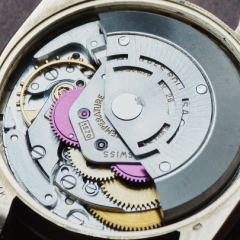Dial (face) cleaning?
-
Recently Browsing
- No registered users viewing this page.
-
Topics
-
Posts
-
One of the things that I've been bothered with lately is timekeeping? For instance a 90-year-old pocket watch what so to timekeeping was it supposed to keep? They publish railroad timekeeping but I don't know how well normal non-railroad watches were supposed to keep time. The reason why the question comes up for me is I spend a lot of time at work adjusting watches to keep really really good time because I have to please my boss where as when the watch was made I have to wonder what kind timekeeping would've been acceptable. After all they typically didn't have timing machines 100 years ago and they were timing and six positions certainly not for the non-railroad grade watch. On the other hand I do get paid by the hour so maybe I shouldn't be concerned of how much time I Spend trying to make everything keep chronometer timekeeping almost. Citing a Delta of 40 seconds for a 90-year-old watch is quite outstanding.
-
That's an interesting question which I don't think I've seen explained anywhere. But I think the problem will go away just about instantaneously. In other words the coating is really thin and it should go away almost immediately. So the problem should resolve itself extremely fast.
-
I experienced that different types of shellac and their ages are affected differently by IPA. Sometimes the shellac dissolves in a few seconds and sometimes several minutes are required. Nowadays I never let shellac come into contact with IPA. It's a hotly debated topic here on WRT if you search. Like John, I don't think you need to worry about the weight of the shellac, but instead that it might start rubbing against something. When I learned how to adjust pallet stones, I tried documenting my experiences in this thread. Hopefully, it can help you. I personally don't believe in the idea of abrading the epilame before oiling so I don't think you need to think or worry about it. The only time I've heard anyone mention this is Alex on the YouTube channel Watch Repair Tutorials but actually no one else. I'm not saying it's "wrong" just that I don't think it's necessary or adds anything.
-
Typically for introductions all you would have to say is hi I am interested in repairing watches and nobody's going to care about the technical details. Then to certain degree the introductions are not life or death in some cases I guess it depends upon what you did when you came to the discussion group. It's good that you're getting a balance complete for variety of reasons and getting a bonus balance bridge. Because I want you to pay attention to something when you get it as your hairspring still has a problem quite an amusing problem in a way. You notice your hairspring stud is a triangle or shape and it fits into a triangular shaped hole. It also notice how your hairspring has some weird bending right around the stud? So when you get your new balance bridge and the balance complete if you look carefully you'll find that I'm pretty sure the stud will be rotated and that they hairspring will come out the end not the way it's coming here you have managed to twist the stud putting it into the hole and that's why it looks so bad in the previous image. If you are skilled at fixing hairsprings which are not you can fix this. On the other hand are getting replacement so that's good. No it's supposed to be straight up and down. So in addition to twisting the stud you also bent it. On the other hand this is the most common place where people like to bend their hairspring and yes if you had practice with bending hairsprings this is all relatively sort of easy to fix. But I would really suggest practicing on another watch or basically scrap of balance wheels off of eBay that nobody cares about. Because practicing on something you care about really isn't the best. Then the reason I wanted the image below was to see how the balance jewel assembly is attached to the bridge. Sometimes it needed jeweling tool to push it out but in this particular case all you have to do is remove the U-shaped clip in the whole thing falls apart. But if you're lucky here replacement balance bridge will solve the problem.
-





.thumb.png.f90dbf035d35248cb483d466310379d3.png)



Recommended Posts
Join the conversation
You can post now and register later. If you have an account, sign in now to post with your account.
Note: Your post will require moderator approval before it will be visible.